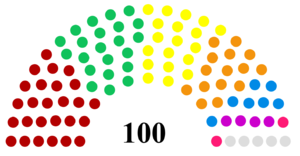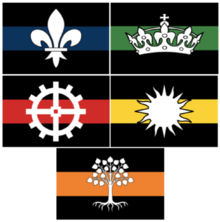Difference between revisions of "Nation/Llorens"
m |
m |
||
| Line 154: | Line 154: | ||
==Geography== | ==Geography== | ||
| − | [[File:Llorens- | + | [[File:Llorens-politicalmap.png|thumb|300px|LGA-approved political map of Llorens]] |
Llorens is a considerably large nation, with 7,038,164km<sup>2</sup> of land. The nation is separated into five states with thirteen major cities. Llorens is officially classified by the Llorens Geographical Association (LGA) as a continent, country, and island. | Llorens is a considerably large nation, with 7,038,164km<sup>2</sup> of land. The nation is separated into five states with thirteen major cities. Llorens is officially classified by the Llorens Geographical Association (LGA) as a continent, country, and island. | ||
Revision as of 04:44, 18 July 2016
Federal Republic of Llorens
|
|||||
|---|---|---|---|---|---|
|
|||||
| Motto: People first! | |||||
Map of Llorens
|
|||||
| Region | The Leftist Assembly | ||||
| Capital and largest city | Zexaro | ||||
| Official languages | English, Llorenian | ||||
| Demonym | Llorenian | ||||
| Government | Federal parliamentary republic | ||||
| - | President | Elisabeth Harland | |||
| - | Vice-President | Josef Cervenka | |||
| Legislature | Parliament of Llorens | ||||
| History | |||||
| - | Discovery | May 5, 2016 | |||
| - | Unification of Llorens | June 11, 2016 | |||
| - | First election | June 24, 2016 | |||
| Area | |||||
| - | Total | 7,038,164 km2 2,717,450 sq mi |
|||
| Population | |||||
| - | 2016 estimate | 325,514,381 | |||
| GDP (PPP) | 2016 estimate | ||||
| - | Total | $21.8 trillion | |||
| - | Per capita | $66,970.93 | |||
| Gini (2016) | 11.72 low |
||||
| HDI (2016) | 0.6369 medium |
||||
| Currency | Llorenç | ||||
| Drives on the | left | ||||
| ISO 3166 code | LLO | ||||
| Internet TLD | .tla | ||||
The Federal Republic of Llorens, more commonly known as Llorens, is a federal republic consisting of five states, Vusmein, Ytelia, Xeñana, Rinturè, and Zana. The country is situated in the region of The Leftist Assembly. The country was first discovered by Captain Vusmein Llorens on May 5, 2016. The nation is notable for having high political freedoms and civil rights, and very low economic freedoms. Llorens is a notably safe and pacifist nation, with compassionate and nice citizens, and a very large welfare program. The nation is part of the World Assembly, and a regular voter in both the Generally Assembly and Security Council. Llorens' national animal is the Lioness, which is a prosperous endemic species commonly found in the nation's abundant forests.
The Llorenian economy is dominated by government activity and state-owned industry, with private enterprise being illegal. 90.9% of the economy is functioned by the government, with the remaining 9.1% being attributed to state-owned industry. The industrial sector, which is highly specialized, is mostly made up of the Tourism industry, with major contributions from Book Publishing and Trout Farming. The average income in Llorens is 67,524 Llorençs.
The Parliament of Llorens is held in Zexaro, the capital city, and is currently lead by the Socialist Party and it's leader, Elisabeth Harland, who is consequently the President of Llorens. The system is unicameral, with one Parliament, and has 100 seats. An election is held every year, with 5 representatives elected to each district. There are 4 districts per each of the 5 states. The most recent election was the Llorenian federal election, 2016.
Contents
History
Expansion
Captain Vusmein Llorens and his crew of sailors discovered the uninhabited island on May 5, 2016, later to be known as Llorens, after presumably escaping from conflict in an unknown land. Llorens went through a rapid establishment period, as there was no resistance or prior inhabitants. The state capital establishments were Zexaro on May 6, 2016, Xeñana City on May 26, 2016, Liteya on May 29, 2016, Zanaville on June 14, 2016, and Xerturini on June 16, 2016.
Unification
The Unification of Llorens was a document created and established on June 11, 2016. It acts as a sort of constitution for the country to this day. The document briefly outlines new guidelines for the unification of the newly discovered island/continent to be named Llorens:
- The island/continent of no-name will be named Llorens and all its land will be unified into this one nation
- Llorens will be split into 5 states: Vusmein, Ytelia, Xeñana, Rinturè, and Zana.
- The capital will be Zexaro, Vusmein
- Annual democratic elections will be held to elect a Parliament, President & Vice-President
Major events
There have been a few major events in Llorens' short history:
- June 24, 2016 - Socialist Party gained most seats in the 1st Election; Elisabeth Harland was appointed as the 1st President
- June 29, 2016 - Bordaro Bridge construction is completed, connecting Ytelia & Vusmein over Bordaro Bay
- July 6, 2016 - First session of Parliament ever
- July 10, 2016 - The Great Zanaville Fire; 231 people died
Politics
Llorens runs under an unicameral political system, with Parliament being the sole parliamentary house. It consists of 100 seats and is held in the capital, Zexaro. The office of the President of Llorens is currently held by Elisabeth Harland, leader of the Socialist Party. The office of the Vice-President of Llorens is currently held by Josef Cervenka, leader of the Green Party.
Political Parties
There are 7 political parties that have seats in Parliament, in addition to five independents:
| Party | Colour | Leader | Main Focus | Seats |
|---|---|---|---|---|
| Socialist Party | Red | Elisabeth Harland | Upholding values of socialism. | 26 |
| Green Party | Green | Josef Cervenka | Prioritising the environment over the economy. | 22 |
| Progressive Party | Yellow | Ludoviko Zabat | Making positive changes to push Llorens forward. | 19 |
| Democratic Party | Orange | Amara Adriaansen | Upholding values of democracy. | 15 |
| Worker's Party | Blue | Stefan Westerburg | Protecting the rights of the working class. | 7 |
| People's Party | Purple | Alberta Bertolini | Putting the interests of citizens first. | 4 |
| National Party | Pink | Dorriane Kuiper | Promoting national pride and unity. | 2 |
| Independents | Grey | 5 |
Elections
Elections are held each year, using a single transferable voting system, to elect 100 representatives for 20 districts in Llorens. To vote, a person must be a Llorenian citizen and 18 years or older. Eligible voters cast their ballot on a single piece of paper displaying each of the parties and candidates for their district. They can either rank all the parties on the left side of the ballot paper, or rank at least 8 candidates on the right side.
Each party may submit a maximum of five candidates per district, so that they have the possibility to gain each seat in that district. The party must also submit a voting order, so that voters for parties, rather than individual candidates, can have their votes distributed accordingly. The reason for having five candidates per district is to advantage minority views, making it more likely that a minor party candidate will be chosen, while still providing citizens with local members of Parliament that will provide attention to their region.
The leader of the party with the most seats in Parliament is elected President, and the leader of the party with the second-most seats in Parliament is elected Vice-President. If either the party with the most seats or second-most seats is tied, a President/Vice-President will be elected by a majority vote in Parliament (excluding members of the tied parties). If this vote is still tied, a national direct vote will select the relevant position.
Ministries
There are eight core ministries of Government in Llorens. Each of these ministries is headed by a minister (e.g. Minister of Health) and a vice-minister (e.g. Vice-Minister of Health). These 16 positions are covered by the main party, currently the Socialist Party, to form a Cabinet, along with the party leader. If there aren't enough members in the main party to cover these positions, this party can choose to form a coalition and offload certain ministries, or these will be given to the second main party of Parliament. The 8 ministries are:
- Ministry of Law
- Ministry of Environment
- Ministry of Health
- Ministry of Education
- Ministry of Culture
- Ministry of Foreign Affairs
- Ministry of Innovation
- Ministry of Social Services
The current Cabinet of the 1st Parliament is:
| Ministry | Minister | Vice-Minister |
|---|---|---|
| Party Leader | Elisabeth Harland | |
| Ministry of Law | Dianne Romanov | Aridai Devine |
| Ministry of Environment | Karolina Abel | Serafino Gerillo |
| Ministry of Health | Dominique Bernard | Viviane Stark |
| Ministry of Education | Adair Airaldi | Auda Bootsma |
| Ministry of Culture | Veselko Steuben | Elisaveta Bastori |
| Ministry of Foreign Affairs | Bartolomeu Berkowitz | Gabriel Koumannes |
| Ministry of Innovation | Silvio Stoyanov | Joanna Vasilev |
| Ministry of Social Services | Malina Jankovic | Anzhela Gouveia |
Proposed Laws
A proposed law may be submitted to the Llorens Law Commission by any member of Parliament, in which it will be reviewed and revised. If the proposed law passes the LLC with a majority vote, it will then be submitted to Parliament. For a proposed law to pass Parliament, it must receive over 50% of the vote (over 50 votes). Any member may choose to abstain from voting, but this doesn't affect the number of votes needed to pass the proposed law in question.
Geography
Llorens is a considerably large nation, with 7,038,164km2 of land. The nation is separated into five states with thirteen major cities. Llorens is officially classified by the Llorens Geographical Association (LGA) as a continent, country, and island.
States
Vusmein is the capital state of Llorens. Its three major cities are Zexaro, Vusmein City, and Niemvusen. Two main geographical landmarks are the Zexaro River and Bordaro Bay. It borders the states of Ytelia, Zana, and Xeñana. Vusmien was named after Captain Vusmein Llorens. The state's colour is green, and its symbol is a crown, representing its role as the capital state.
Ytelia is one of the five states of Llorens. Its three major cities are Liteya, Port Llorenç, and Point Ytelia. Two main geographical landmarks are Bordaro Bay, and Ytelia Bay. It borders the states of Zana, and Vusmein. Ytelia was named after General Ytelia. The state's colour is yellow, and its symbol is a sun, representing the new light of socialism.
Xeñana is one of the five states of Llorens. Its two major cities are Xeñana City, and Zantañas. A main geographical landmark is the Bay of Ceybisa. It borders the states of Vusmein, and Rinturè. Xeñana was named after General Xeñana. The state's colour is red, and its symbol is a wheel, representing the sailors who inhabited the land.
Rinturè is one of the five states of Llorens. Its three major cities are Xerturini, Porterano, and Notonfigo. A main geographical landmark is Rinturè Bay. It borders the states of Zana and Xeñana. Rinturè was named after General Rinturè. The state's colour is blue, and its symbol is a fleur-de-lis, representing the working-class nature of Rinturians.
Zana is one of the five states of Llorens. Its two major cities are Zanaville, and Valstana. It borders the states of Ytelia, Vusmein, and Rinturè. Zana was named after General Zana. The state's colour is orange, and its symbol is a tree, representing its roots in the nation's pacifist history.







